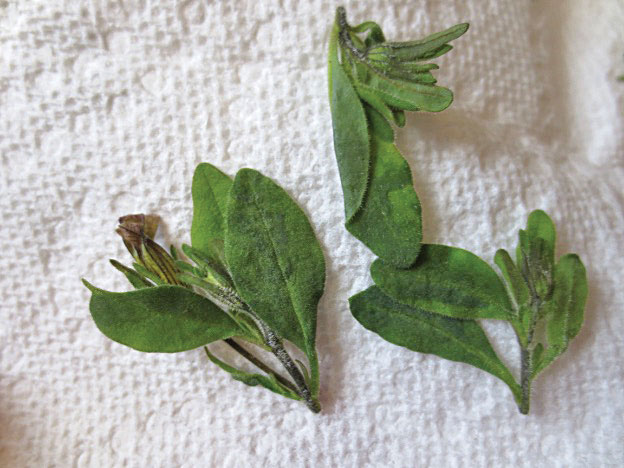6/1/2022
Chili Pepper Mild Mottle Virus
Nora Catlin & Margery Daughtrey
(Editor’s note: This was originally published in the March 2022 issue of the e-Gro Alert newsletter.—JZ)
There’s a new virus to be worried about: chili pepper mild mottle virus (CPMMoV). CPMMoV has been found on calibrachoas this season, and similar to tobacco mosaic virus (TMV), CPMMoV can be spread by handling.
Symptoms on calibrachoa include mild or bright yellow mottling (irregular yellow areas bordered by green tissue), flower break (irregular flower color patterns), necrotic spots and/or general stunt.
Little is currently known about this virus, but we do know that it’s classified as a tobamovirus and is related to tobacco TMV in that it can spread easily via workers’ hands and tools. CPMMoV is not spread by insects.
 Pictured: Mild mottle in the foliage is seen here without any of the dramatic flower break symptoms. They’re so subtle that it will be hard for anyone to notice them or to find them even if they’re looking for them.
Pictured: Mild mottle in the foliage is seen here without any of the dramatic flower break symptoms. They’re so subtle that it will be hard for anyone to notice them or to find them even if they’re looking for them.
Since the host range of CPMMoV is not yet well defined, you should err on the side of caution and assume that additional plants are susceptible, and you should treat this virus as you would treat TMV in your greenhouse. Be especially watchful of other plants in the Solanaceae family—plants in this family include petunia, nicotiana, browallia, datura, pepper, tomato and eggplant. Note that if you’re growing transplants for local farmers, the CPMMoV is a potential threat to some of their most important crops.
Tobamoviruses in general are known to be more stable outside their plant hosts than most other viruses, so you should assume that the particles of CPMMoV would be as well—meaning that surfaces such as doorknobs, steering wheels, benches and other objects that have been handled after infected plants can harbor virus particles. They’re much more long-lasting than COVID-19 particles.
Pictured : You can clearly see both the mild mottle in the foliage and the color breaking in the petals.
: You can clearly see both the mild mottle in the foliage and the color breaking in the petals.
If you see symptoms of this virus, or you know that you’ve received plants that have this virus, you should use strict sanitation practices. Avoid handling infected plants prior to handling healthy plants. Be sure to have a program of sanitizing workers’ hands and tools to minimize potential spread between plants during transplant and during other handling tasks. Rogue and discard infected plants—carefully—and make sure to clean and sanitize the work and growing surfaces, as well as workers’ hands after handling calibrachoas.
Have workers wear disposable gloves, and provide them with wash stations, including soap and water plus disposable paper toweling.
Disinfest contaminated tools and surfaces with a bleach solution (a 10% solution, one part bleach:nine parts water, is effective with a 6% sodium hypochlorite bleach; adjust if your product has a higher or lower concentration of active ingredient) or a solution of a product such as 2% Virkon S (following all label directions).
A 20% solution of milk is often recommended as an effective product to disinfest tools and surfaces during TMV outbreaks; however, whether or not milk formulations will be as effective against this particular tobamovirus is unknown. While a milk solution has been shown to be effective as a disinfectant for TMV and some other tobamoviruses, one recent study showed that a 10% milk solution was ineffective against the tobamoviruses tomato brown rugose fruit virus (ToBRFV) and cucumber green mottle mosaic virus (CGMMV) (note that the 10% in this study is lower than the usual 20% concentration of nonfat dried milk used to inactivate TMV).
 Pictured: Leaves with mottling that were tested with an Agdia immunostrip test for TMV … and got a positive.
Pictured: Leaves with mottling that were tested with an Agdia immunostrip test for TMV … and got a positive.
Some good news is that CPMMoV will cross-react with TMV test strips, so TMV test strips can be used to diagnose this virus and to confirm an infection. Even though you won’t know exactly which tobamovirus is present in the tissue, a positive test indicates that you have a plant that should be carefully discarded, along with others that have similar symptoms. GT
Dr. Nora Catlin is a Floriculture Specialist at the Cornell Cooperative Extension in Suffolk County. Margery Daughtrey is a Senior Extension Associate for Cornell University Section of Plant Pathology and Plant-Microbe Biology at the Long Island Horticultural Research & Extension Center.